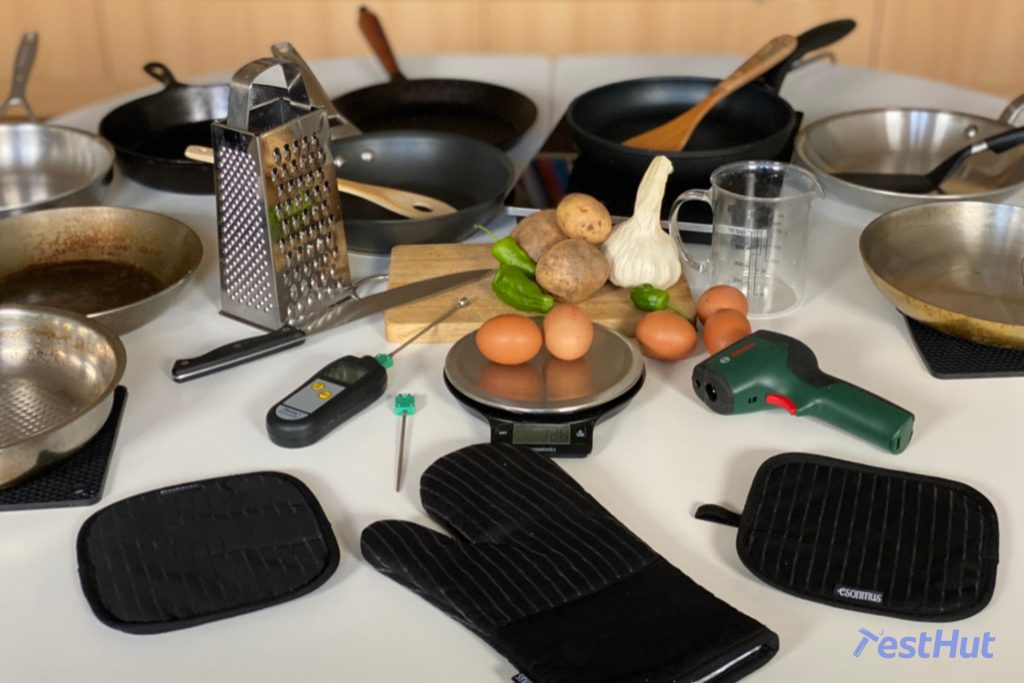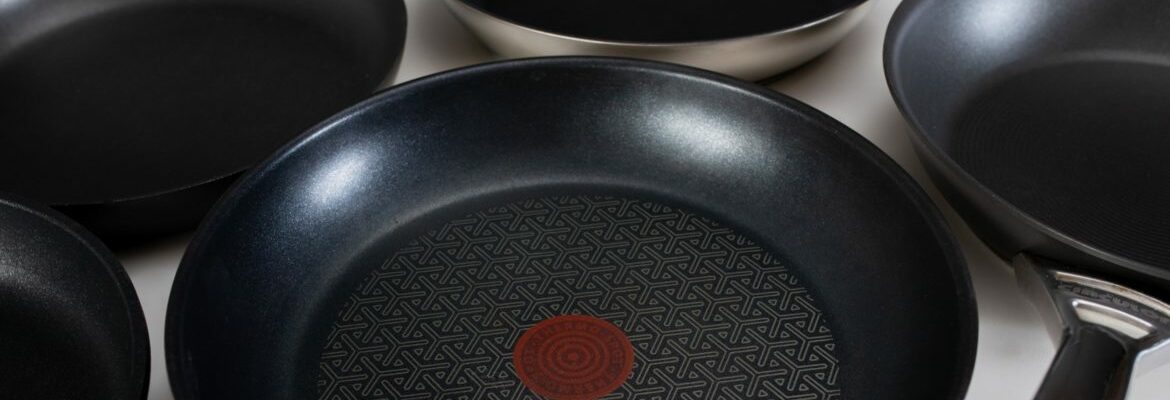Choosing the Best Non-Stick Pan for Your Cuisine
A non-stick frying pan is a must-have for most kitchens because they let you cook things that would normally stick to other pans and cleaning up is super easy. However, not all non-stick pans are built the same, so you should choose one that will last long and perform well. We have found some of the best non-stick pans available to help you narrow down your options.
Tramontina Professional Aluminum Nonstick Restaurant Fry Pan, 10", NSF-Certified, Made in Brazil
Best overall
The Tramontina Professional non-stick pan is an excellent choice for both the professional and home cook. It is durable, made of heavy-gauge aluminum, and the non-stick coating is designed to last.
Pros
- Sturdy and well-built
- Cooks very well
- Great non-stick surface
- Works on all hob types
- Silicone grip keeps handle cool
Cons
- Not induction compatible
- Can be hard to keep the interior rivets clean
- Delicate surface needs to be treated with care
Review
Our pick for the overall best non-stick pan is the Tramontina PRO Series Restaurant Fry Pan which is an excellent choice for those seeking a durable and adaptable frying pan.
This pan is designed to meet the demands of professional kitchens but is also suitable for home use. The commercial-grade heavy-gauge aluminum construction ensures heat is distributed evenly and quickly for consistent cooking results. The reinforced non-stick interior also makes cooking and cleaning effortless. Eggs will slide around this pan even without using oil.
The cast stainless steel handle is firmly attached with three solid rivets, providing additional support. On the downside, these rivets are a bit harder to keep clean than the rest of the pan. The included removable silicone grip is comfortable to hold, keeping your hand cool, and it can be used in and out of the oven.
The pan is NSF certified, which means they meet rigorous standards used for commercial cookware. It is also compatible with gas, electric, and ceramic glass cooktops, and can be used in the oven up to 400ºF. However, it is not induction ready.
One of the standout features of these pans is their PFOA-free high-performance non-stick coating. This allows food to easily release from the pan, making cooking and cleanup much easier. Like any non-stick pan, this surface is delicate, and you should avoid metal utensils and hand wash the pan for a longer life.
We think that the Tramontina PRO Series 10” Fry Pan is a great choice for any home or professional chef who wants a non-stick performance that is built to last.
OXO Good Grips Pro 10" Frying Pan Skillet, 3-Layered German Engineered Nonstick Coating, Stainless Steel Handle, Dishwasher Safe, Oven Safe, Black
Runner up
This OXO non-stick frying pan is known for its ease of use and comfortable grip. On top of that, it is lightweight and the anodized aluminum construction is durable and easy to clean.
Pros
- Heats up quickly
- Lightweight and easy to maneuver
- Comfortable steel handle
- Anodized construction is durable
- Super easy to clean
Cons
- Not for induction
- non-stick coating may be easily damaged
- Can be hard to get a spatula under food
Review
Our runner-up is the OXO Good Grips Pro 10″ Frying Pan Skillet which is an excellent choice for anyone looking for a high-quality, non-stick pan.
It features a three-layer, German-engineered non-stick coating, providing excellent performance and longevity. The hard anodized aluminum body has excellent heat conduction, ensuring that your food cooks evenly, and it is also scratch-resistant, making it a durable option for everyday use. However, for longevity, you should avoid using metal utensils, and always hand-wash non-stick pans for best results.
One of the standout features of this pan is its comfortable stainless steel handle, which is oven safe up to 430°F. This allows you to transfer the pan from the stovetop to the oven with ease, making it a versatile cooking tool. The rolled edges also ensure that pouring liquids is drip-free, making clean-up a breeze.
When it comes to cooking, the OXO Good Grips Pro 10″ Frying Pan Skillet is ideal for a variety of foods. It’s perfect for making crispy, evenly browned pancakes or eggs, and it’s also great for sautéing vegetables, stir-frying, or searing meat. With its non-stick surface, you won’t have to worry about food sticking to the pan, and you can use less oil for healthier cooking.
Note that this pan is made of anodized aluminum which is not induction compatible, but it will work great with gas and electric stoves.
You will find that this OXO Good Grips Pro 10″ Frying Pan Skillet is an excellent investment for anyone who values high-quality cookware that is easy and comfortable to cook with.
Blue Diamond Cookware Diamond Infused Ceramic Nonstick 8" Frying Pan Skillet, PFAS-Free, Dishwasher Safe, Oven Safe, Blue
Best Ceramic
This Blue Diamond pan is a budget-friendly option that gives you everything you want in a non-stick pan. It comes in multiple colours, has great release, and is even oven safe for versatility.
Pros
- Good value for the money
- Comes in multiple colours
- Great non-stick release
- Oven safe
- Easy to clean
Cons
- Not induction compatible
- May scratch easily
- Bottom surface is a bit small
Review
The Blue Diamond Diamond-Infused Ceramic non-stick 10″ Frying Pan is an excellent choice for those who are looking for an affordable yet high-quality non-stick pan.
One of the standout features of this pan is its diamond-infused ceramic non-stick coating, which is durable and relatively long-lasting. The diamonds are conductive, which means the pan heats fast and is easy to clean. This pan is also toxin-free, being free of PFAS, PFOA, lead, and cadmium.
The heavy-duty forged base of the pan prevents warping, wobbling, or degrading over time, ensuring that it will last for many years to come. It is oven and broiler safe up to 600°F, making it a versatile cooking tool, and it is dishwasher-safe for easy clean-up. However, non-stick coatings will generally last longer if you wash the pan by hand.
The riveted stainless steel handle provides a secure and comfortable grip, making it easy to handle the pan, even when it is full of food. Thanks to the design, it also stays relatively cool while cooking.
When it comes to cooking, the Blue Diamond pan is perfect for a variety of foods, including pancakes, eggs, vegetables, and meat. The non-stick surface ensures that food won’t stick to the pan, and you can use less oil for healthier cooking. It will work on most stoves except for induction.
We think that this Blue Diamond Ceramic non-stick 10″ Frying Pan is an excellent investment for those who are looking for an affordable, high-quality non-stick pan.
Swiss Diamond Nonstick Fry Pan-9.5"
Best premium
For premium cooking results time and time again, you can trust the Swiss Diamond XD non-stick pan. It is built to the highest standards and offers even heating and impressive non-stick performance.
Pros
- Impressive non-stick performance
- Durable construction that is built to last
- Super easy to clean
- Even heating
- Handle is sturdy and stays cool
Cons
- Not induction compatible
- Somewhat expensive
Review
The Swiss Diamond 10.25 Inch Frying Pan is a premium quality cookware that is designed for everyday use. This pan boasts a patented non-stick coating that is reinforced with diamonds, providing a healthy cooking experience without the need for excess oil or fat. This makes it a great option for anyone looking to cook healthier meals.
One impressive feature of this pan is that it has an incredibly even cooking performance. The cast aluminum body ensures that heat is distributed evenly throughout the pan without any hotspots, while the perfectly flat bottom ensures that the pan will not tip, spin, or warp over time. This makes it ideal for cooking delicate foods such as omelets and crepes, which require an even heat source to cook properly. You will also be impressed with just how flat the pan is with no dips or bowing.
In terms of comfort and convenience, the Swiss Diamond 10.25 Inch Frying Pan is excellent. The ergonomic handles provide a comfortable and safe grip and are designed to stay cool on the stovetop. The rivet-free cooking surface makes cleaning up a breeze, as there are no hard-to-reach crevices for food to get stuck in.
The pan is also oven safe up to 500 degrees Fahrenheit, making it possible to bake a variety of dishes such as roasted vegetables, frittatas, or even cakes. The pan is also dishwasher safe, although hand washing is recommended to extend its lifespan.
Overall, the Swiss Diamond 10.25 Inch Frying Pan is a high-quality, versatile, and well-designed cookware that will serve you well in your kitchen. The only potential downside is its price, which is on the higher side compared to other frying pans. However, with its limited lifetime warranty, you can be confident in your investment in this pan.
Tefal 30 cm Comfort Max, Induction Frying Pan, Stainless Steel, Non Stick
Best for induction
This Tefal Comfort Max offers a solid combination of a durable nonstick coating with stainless steel construction. It works on all hobs including induction, and the handle is very comfortable.
Pros
- Works with all hobs including induction
- Comfortable handle
- Great non-stick properties
- Well-constructed pan
- Works with all hobs including induction
- Easy to control heat
Cons
- A bit expensive
- A bit heavy
Review
The Tefal 30 cm Comfort Max Induction Frying Pan is a top-of-the-line piece of cookware that features an induction-compatible base which works seamlessly with induction cooktops, and its stainless steel construction ensures that it will last for years to come with proper care.
Additionally, the pan’s exterior has a durable non-stick coating that makes it easy to clean and helps to prevent food from sticking. The pan is so slick that you can easily cook many foods without adding any oil at all.
In addition, it’s dishwasher safe, so you can simply pop it in the dishwasher when you’re finished cooking, and it is PFOA-free, so you won’t have to worry about any harmful chemicals leaching into your food.
The Tefal Comfort Max Induction Frying Pan also features the innovative Thermo spot technology that lets you know when the pan has reached the optimum temperature to start cooking, making it easy to get perfect results every time.
The pan’s handle is securely attached to the body with sturdy stainless steel rivets, ensuring it won’t come loose over time. The handle is also made from a heat-resistant material, so you won’t have to worry about it getting hot while you’re cooking. In fact, the handle of the Comfort Max series of pans is one of the most comfortable that you will find.
On the downside, it is a stainless steel pan with a disc, so it is heavier than aluminum non-stick pans of the same size.
We think that if you’re looking for a high-quality induction pan that’s built to last and offers the convenience of easy cleaning, the Tefal 30 cm Comfort Max Induction Frying Pan is definitely worth considering.
Non-stick pan buying guide
Finding the best non-stick frying pan that suits your everyday cooking needs is not an easy task. There are thousands of pans to choose from, and manufacturers use confusing product descriptions, like a super-strong two-coat Eterna system or triple granite coating. But what does it all mean? Our buying guide will explain the basics of the non-stick frying pan world.
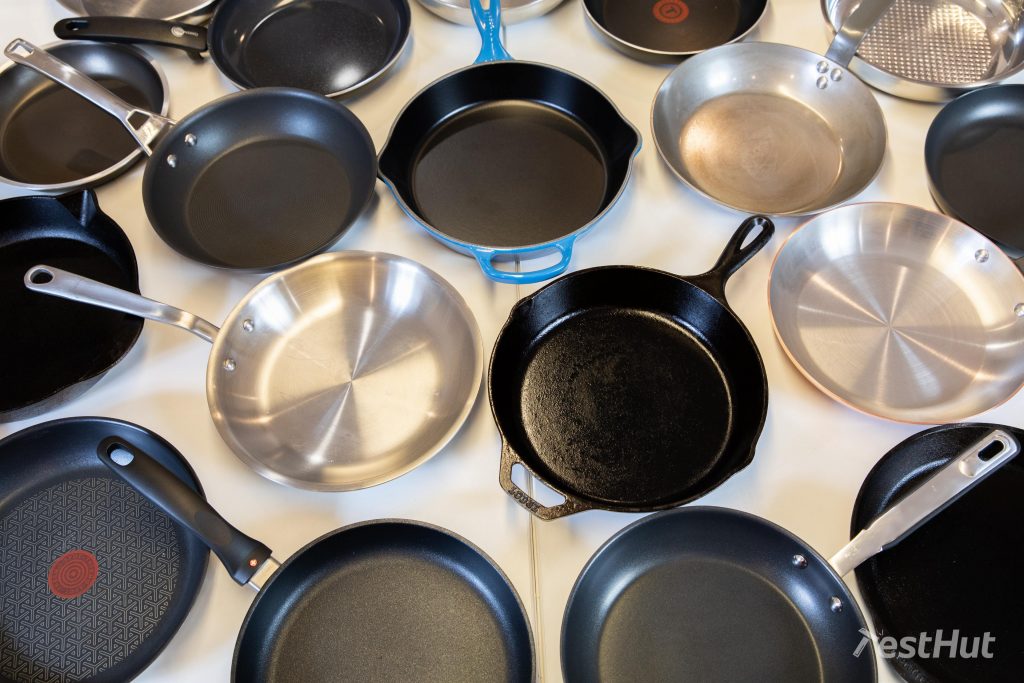
Non-stick coatings
The coating is the essence of a non-stick pan. This is what prevents food from sticking and makes non-stick pans easy to use. The coating will eventually wear down, and there is no way to repair it. Therefore, no non-stick pan will ever last as long as uncoated metal pans like stainless and cast iron, but some coatings are more durable than others.
Generally, there are two types of non-stick coatings: PTFE and ceramic. PTFE is commonly known as Teflon, but that is just Duponts’ brand name for their PTFE product. This coating has been around for decades. But due to growing health concerns about the chemicals linked to Teflon, an alternative coating has emerged, ceramic.
When you get a non-stick pan, you are hoping that it will have a good “release.” The release is the term used to describe just how well the non-stick coating allows food to move around the pan. A good non-stick pan will allow you to cook foods like fried eggs with little or no oil, so this is a nice feature to look for.
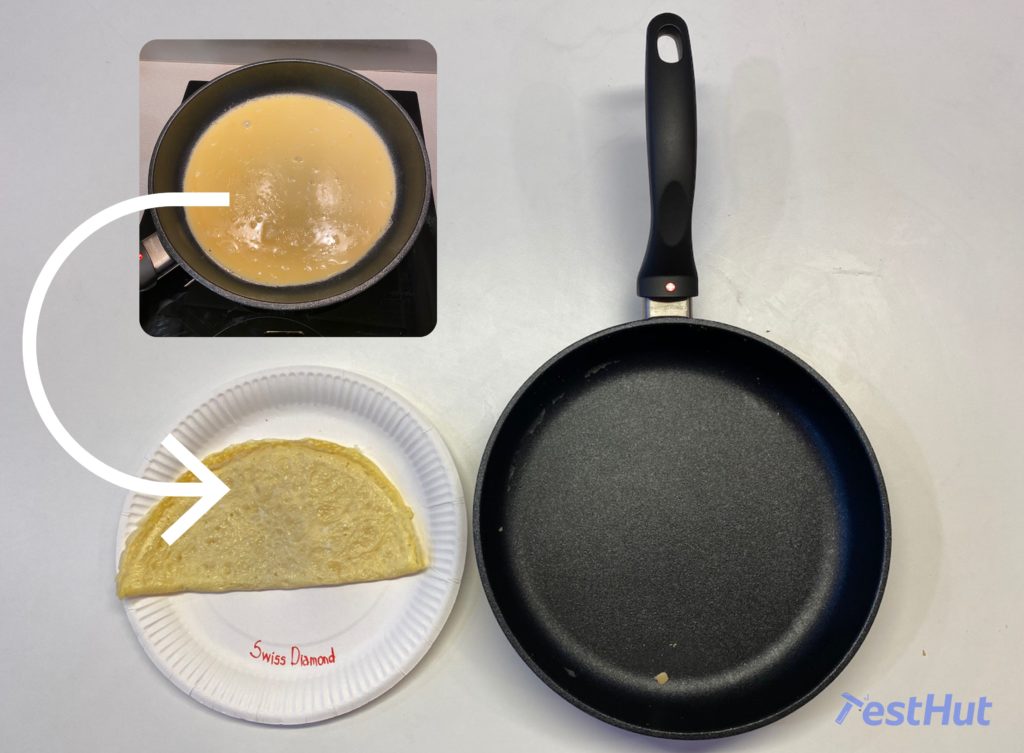
Teflon coatings
Teflon has a bad reputation in some circles, and there is a reason for this. Historically Teflon was bonded to pans using PFOA or Perfluorooctanoic acid, which has been shown to be carcinogenic. Nowadays, this substance is no longer used in the manufacturing process of Teflon but be sure, always check if the manufacturer indicates that the pan is “PFOA-free”.
Now manufacturers use Gen X or other synthetic polymers known as thermoplastics. The most popular coating is Teflon, but some manufacturers also use different brands like Eterna or Quantanium which are also PTFE-based coatings.
Health organizations claim that PTFE-based coatings are safe up to 270°C. Above this temperature, PTFE can start to break down and release chemicals in the air, which may cause flu-like symptoms for humans, but can be lethal for pets, especially birds. So, don’t overheat any non-stick cookware! If used properly, there are no proven risks to humans from PTFE coatings.
PTFE is still the most popular type of non-stick coating because it is easily accessible and it makes cooking so easy. PTFE coatings tend to scratch easily and are likely to flake, but ingesting small flakes of the non-stick coating is not considered dangerous. If you want to buy a Teflon pan, look for pans with multiple layers of coating because these are more durable and will last longer. Avoid using metal utensils even if the manufacturer says this is okay.
Ceramic coatings
Ceramic coatings are gaining popularity as a healthier alternative to Teflon. Some say that ceramic still has a lot of disadvantages: it wears off even faster than Teflon and the coating is more prone to sticking. In our tests, we found this to be false.
Ceramic pans can perform as well as Teflon, but there are some differences for sure. The coatings are generally made from sand, which is turned into sol-gel. Since ceramic pans are made of harder, more brittle materials than Teflon, we found that ceramic coatings are harder to scratch; but when they do start to chip and crack, they will wear down faster.
The most popular ceramic coatings are Thermolon and Greblon. But to be sure that the pan is actually ceramic-coated, check to make sure the manufacturer says ‘’PTFE-free’’.
The negative reputation of Teflon has created a wave of misleading marketing claims. Brands use terms like stone or granite coating to make you believe that these pans have natural coatings. But in reality, most of these also are simply colored PTFE coatings. Only when the manufacturer states ‘’PTFE-free’’ can you be sure that it is ceramic.
Care
No matter which non-stick coating you choose, both require special. non-stick coatings are brittle, and when they start to wear off, the pan loses its non-stick performance. To avoid scratching, always use non-metal cooking utensils, like wood, plastic, or silicone. Even if the manufacturer says that the coating is metal safe, we advise sticking with gentler options.
As it is with all types of pans, always cool the pan before washing. With non-stick pans, we suggest avoiding machine washing. Although some pans claim to be dishwasher safe, this may wear down the coating faster. Instead, wash by hand with soapy water and a gentle sponge. Never scrub.
To avoid accidentally scratching the coating when storing the pan, always use some kind of protective layer between the pans if you stack them. A simple paper towel will be enough, but you can also purchase pan protectors in all shapes and sizes.
Another thing you want to avoid with non-stick pans is a spray can oil like Pam. These can adhere to the surface and actually make the original non-stick coating less effective over time. Natural oils are okay to use, but always avoid overheating.
Construction of the pan
There is more to a non-stick pan than just the coating. To ensure even heating and steady temperature, the material of the pan is important. Generally, non-stick pans are made of either aluminum or stainless steel.
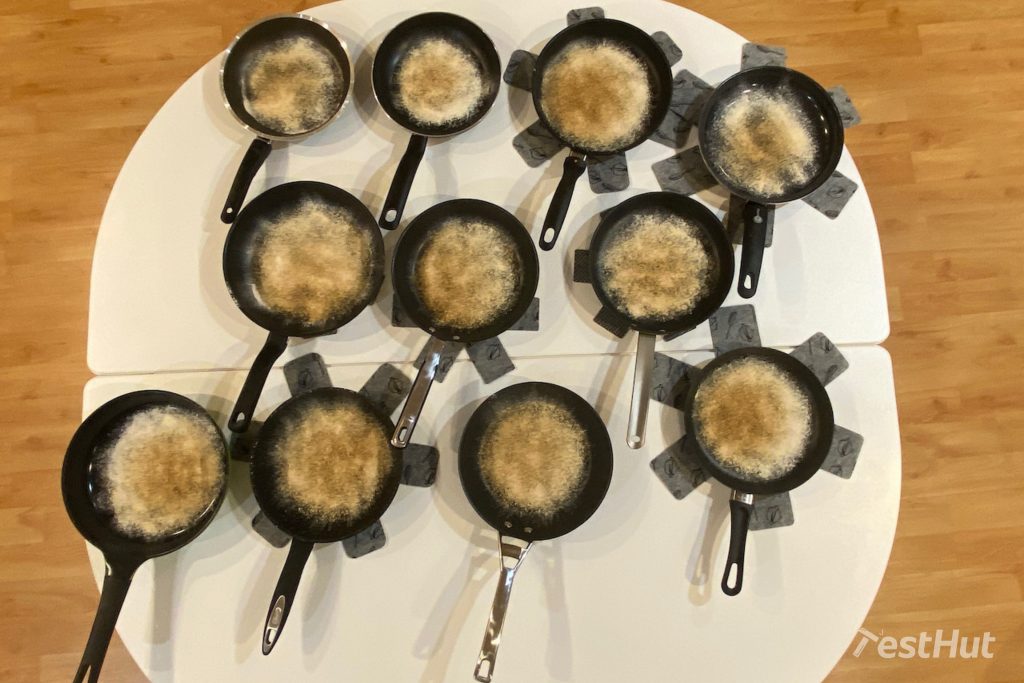
Aluminum pans
Aluminum pans are usually cheaper, but their quality depends on the manufacturing process. Stamped aluminum pans are very thin, so they are not as durable, but people choose them because of their lower price point. On the downside, they are more likely to warp.
Cast aluminum pans are made by pouring liquid aluminum into a mould, where it solidifies into the desired shape. Cast aluminum pans are high quality and quite durable, which may result in a higher price point.
A forged aluminum pan is made by heating a piece of aluminum to a high temperature, then shaping it into a pan using a mould and a press. This process, known as forging, gives the aluminum increased strength. Forged aluminum pans are heavier and less prone to warping.
The last type of aluminum pan is anodized. The making of anodized pans includes one of the methods mentioned above, but the aluminum is hardened using an electrochemical process to make it less reactive and more durable.
Although aluminum pans are relatively inexpensive, the material itself has great heating properties, heating up quickly and evenly while being responsive to temperature changes.
Stainless pans
Other non-stick pans are made of stainless steel, which is not a great heat conductor alone. Therefore, stainless pans usually have a layer of aluminum or other types of metal bonded to the body.
Stainless pans can be divided into clad and disc pans. Clad pans have a reputation for quality and better heating performance. We tested two non-stick stainless steel pans with a disc bottom. These pans tended to get hotter faster, which is not safe for PTFE coatings.
Most non-stick pans will be suitable for electric, ceramic tops, and gas stoves. Induction users have to check whether their aluminum and stainless non-stick pans will work on induction. These materials need an additional plate of magnetic metal to work on an induction stove.
What size do I need?
The size of the pan is very important to make sure you have a pan big enough for your needs while avoiding overcrowded food. The most common size is 10 inches, which will suit most people. This size will be enough for 2–3 people. If you’re cooking for a larger family, choose a 12-inch pan, but be sure that you have a hob that supports such a size.
Smaller pans like an 8-inch diameter pan will be more suitable for breakfast to fry 1 or 2 eggs. Even if you are cooking for 1–2 people, we advise getting at least a 10-inch pan to comfortably cook, flip, and stir without spilling.
The shape of the pan impacts the actual size of the cooking surface. Nevertheless, manufacturers still use the overall diameter instead of the cooking area. If your chosen pan has wider sidewalls, the cooking area will be smaller.
How much should I pay?
The price of non-stick pans ranges quite a bit with chapter pans going for less than $20 and the most expensive non-stick pans costing more than $200. As with any product, you generally get what you pay for. You can expect a cheap non-stick pan to basically be disposable, lasting a few months before the coating wears off or the pan gets damaged. However, since non-stick pans do not last forever, it is hard to justify paying too much for one that will wear out in a few years. On the other hand, a well-built pan is just better to cook with and will generally have better release than a less expensive pan.
You should check the warranty information of the pan carefully and read user reviews. Some manufacturers give “lifetime guarantees”, but these usually have some conditions, and do not cover general wear and tear over time.
Conclusion
If you want to buy a non-stick frying pan, first, decide if you are comfortable with the PTFE (Teflon) coating or the ceramic. Consider the price you are willing to pay while considering that no non-stick pan will last forever. Look for durable pans (forged or anodized aluminum) with multiple layers of coating. But most importantly, always remember to use your non-stick with care to extend its life.
